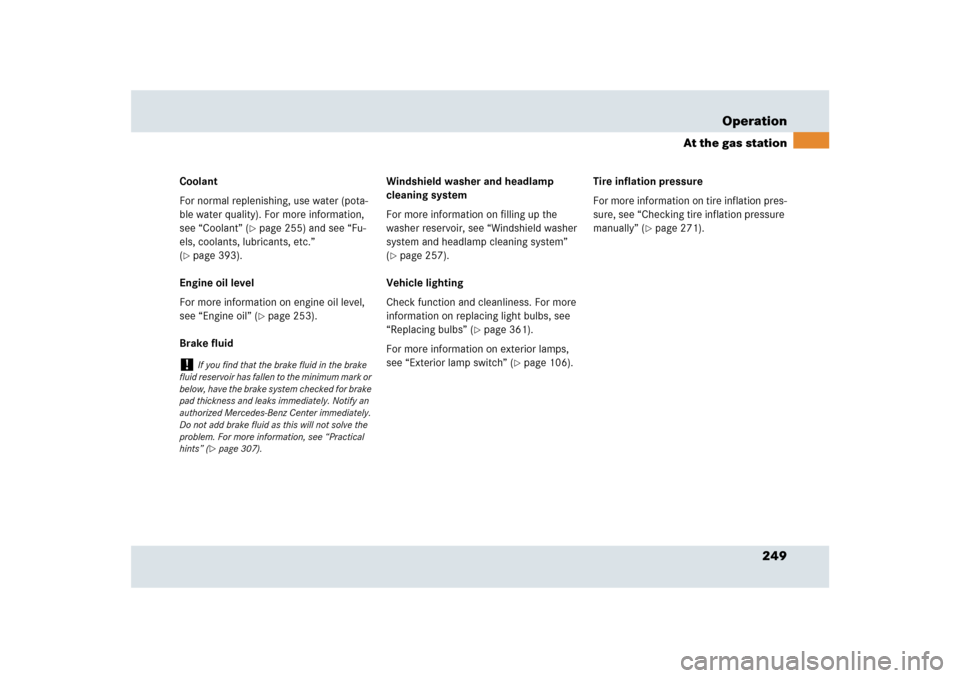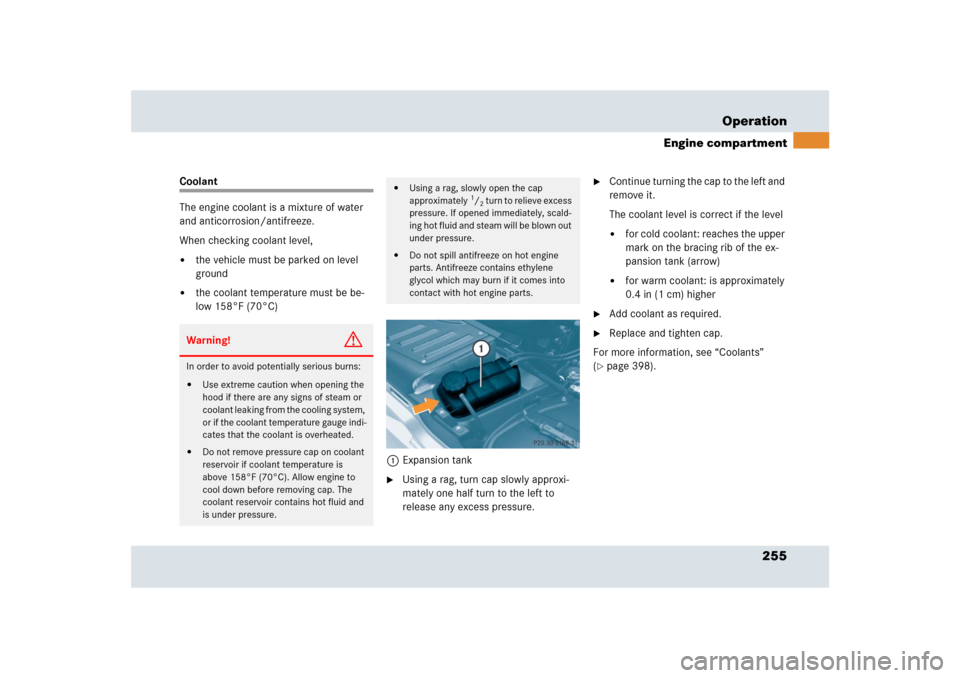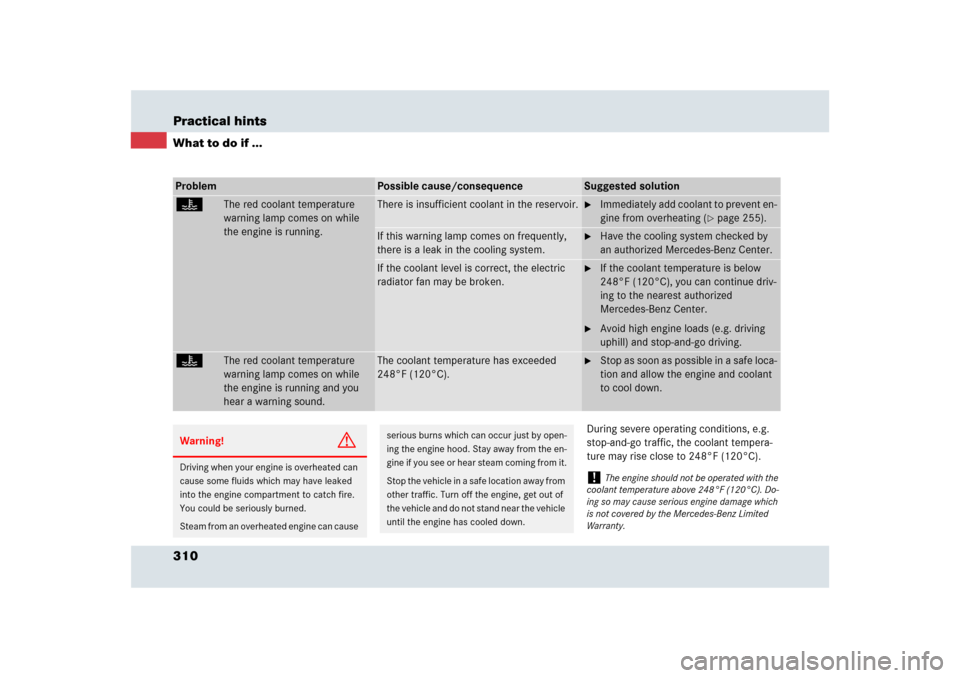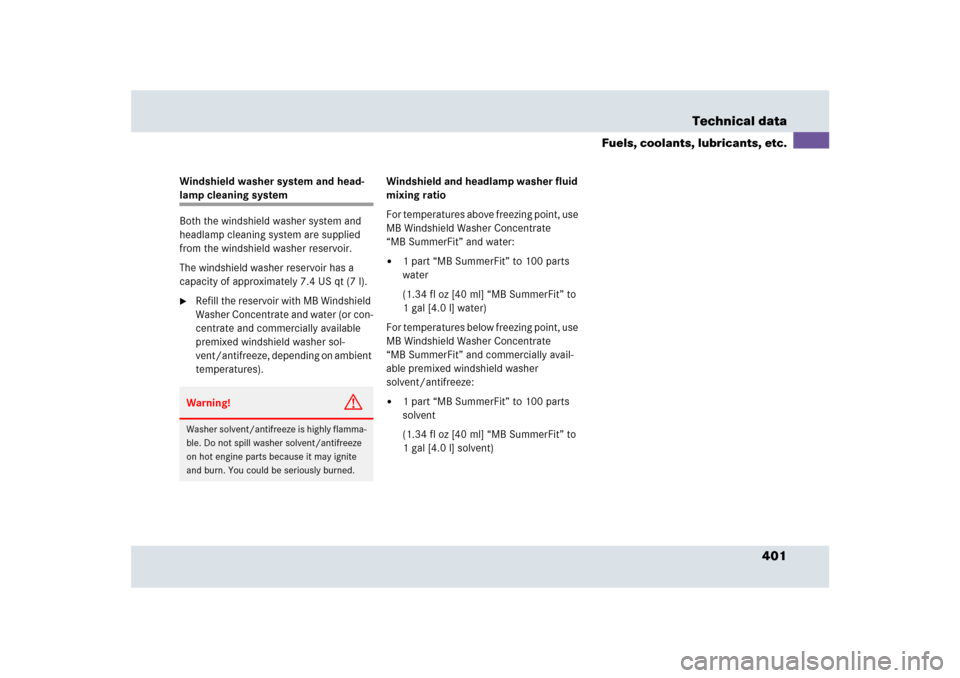Page 249 of 426

249 Operation
At the gas station
Coolant
For normal replenishing, use water (pota-
ble water quality). For more information,
see “Coolant” (
�page 255) and see “Fu-
els, coolants, lubricants, etc.”
(
�page 393).
Engine oil level
For more information on engine oil level,
see “Engine oil” (
�page 253).
Brake fluidWindshield washer and headlamp
cleaning system
For more information on filling up the
washer reservoir, see “Windshield washer
system and headlamp cleaning system”
(
�page 257).
Vehicle lighting
Check function and cleanliness. For more
information on replacing light bulbs, see
“Replacing bulbs” (
�page 361).
For more information on exterior lamps,
see “Exterior lamp switch” (
�page 106).Tire inflation pressure
For more information on tire inflation pres-
sure, see “Checking tire inflation pressure
manually” (
�page 271).
!
If you find that the brake fluid in the brake
fluid reservoir has fallen to the minimum mark or
below, have the brake system checked for brake
pad thickness and leaks immediately. Notify an
authorized Mercedes-Benz Center immediately.
Do not add brake fluid as this will not solve the
problem. For more information, see “Practical
hints” (�page 307).
Page 255 of 426

255 Operation
Engine compartment
Coolant
The engine coolant is a mixture of water
and anticorrosion/antifreeze.
When checking coolant level,�
the vehicle must be parked on level
ground
�
the coolant temperature must be be-
low 158°F (70°C)
1Expansion tank
�
Using a rag, turn cap slowly approxi-
mately one half turn to the left to
release any excess pressure.
�
Continue turning the cap to the left and
remove it.
The coolant level is correct if the level �
for cold coolant: reaches the upper
mark on the bracing rib of the ex-
pansion tank (arrow)
�
for warm coolant: is approximately
0.4 in (1 cm) higher
�
Add coolant as required.
�
Replace and tighten cap.
For more information, see “Coolants”
(
�page 398).
Warning!
G
In order to avoid potentially serious burns:�
Use extreme caution when opening the
hood if there are any signs of steam or
coolant leaking from the cooling system,
or if the coolant temperature gauge indi-
cates that the coolant is overheated.
�
Do not remove pressure cap on coolant
reservoir if coolant temperature is
above 158°F (70°C). Allow engine to
cool down before removing cap. The
coolant reservoir contains hot fluid and
is under pressure.
�
Using a rag, slowly open the cap
approximately
1/2 turn to relieve excess
pressure. If opened immediately, scald-
ing hot fluid and steam will be blown out
under pressure.
�
Do not spill antifreeze on hot engine
parts. Antifreeze contains ethylene
glycol which may burn if it comes into
contact with hot engine parts.
Page 310 of 426

310 Practical hintsWhat to do if ...
During severe operating conditions, e.g.
stop-and-go traffic, the coolant tempera-
ture may rise close to 248°F (120°C).
Problem
Possible cause/consequence
Suggested solution
D
The red coolant temperature
warning lamp comes on while
the engine is running.
There is insufficient coolant in the reservoir.
�
Immediately add coolant to prevent en-
gine from overheating (
�page 255).
If this warning lamp comes on frequently,
there is a leak in the cooling system.
�
Have the cooling system checked by
an authorized Mercedes-Benz Center.
If the coolant level is correct, the electric
radiator fan may be broken.
�
If the coolant temperature is below
248°F (120°C), you can continue driv-
ing to the nearest authorized
Mercedes-Benz Center.
�
Avoid high engine loads (e.g. driving
uphill) and stop-and-go driving.
D
The red coolant temperature
warning lamp comes on while
the engine is running and you
hear a warning sound.
The coolant temperature has exceeded
248°F (120°C).
�
Stop as soon as possible in a safe loca-
tion and allow the engine and coolant
to cool down.
Warning!
G
Driving when your engine is overheated can
cause some fluids which may have leaked
into the engine compartment to catch fire.
You could be seriously burned.
Steam from an overheated engine can cause
serious burns which can occur just by open-
ing the engine hood. Stay away from the en-
gine if you see or hear steam coming from it.
Stop the vehicle in a safe location away from
other traffic. Turn off the engine, get out of
the vehicle and do not stand near the vehicle
until the engine has cooled down.
!
The engine should not be operated with the
coolant temperature above 248°F (120°C). Do-
ing so may cause serious engine damage which
is not covered by the Mercedes-Benz Limited
Warranty.
Page 401 of 426

401 Technical data
Fuels, coolants, lubricants, etc.
Windshield washer system and head-lamp cleaning system
Both the windshield washer system and
headlamp cleaning system are supplied
from the windshield washer reservoir.
The windshield washer reservoir has a
capacity of approximately 7.4 US qt (7 l).�
Refill the reservoir with MB Windshield
Washer Concentrate and water (or con-
centrate and commercially available
premixed windshield washer sol-
vent/antifreeze, depending on ambient
temperatures).Windshield and headlamp washer fluid
mixing ratio
For temperatures above freezing point, use
MB Windshield Washer Concentrate
“MB SummerFit” and water:
�
1 part “MB SummerFit” to 100 parts
water
(1.34 fl oz [40 ml] “MB SummerFit” to
1gal [4.0l] water)
For temperatures below freezing point, use
MB Windshield Washer Concentrate
“MB SummerFit” and commercially avail-
able premixed windshield washer
solvent/antifreeze:
�
1 part “MB SummerFit” to 100 parts
solvent
(1.34 fl oz [40 ml] “MB SummerFit” to
1 gal [4.0 l] solvent)
Warning!
G
Washer solvent/antifreeze is highly flamma-
ble. Do not spill washer solvent/antifreeze
on hot engine parts because it may ignite
and burn. You could be seriously burned.